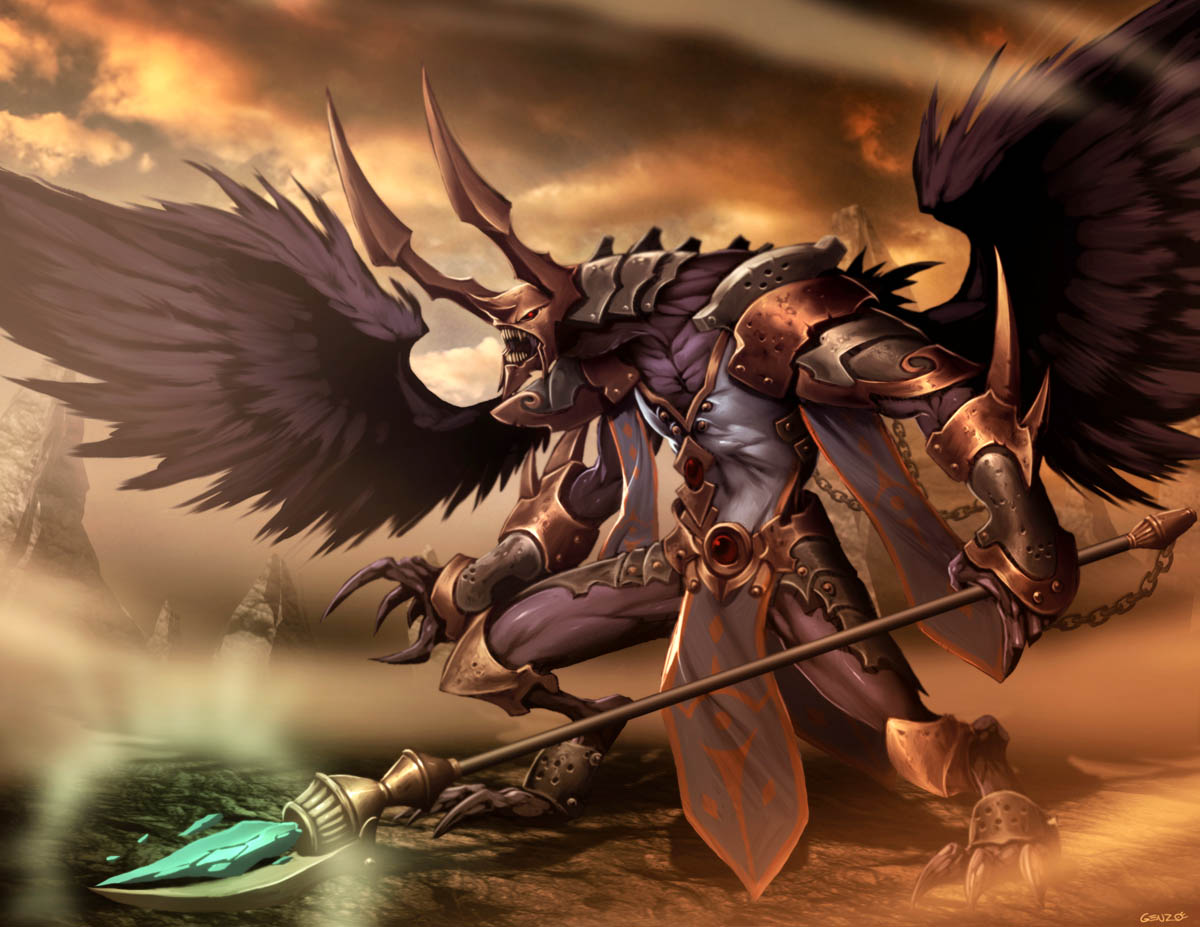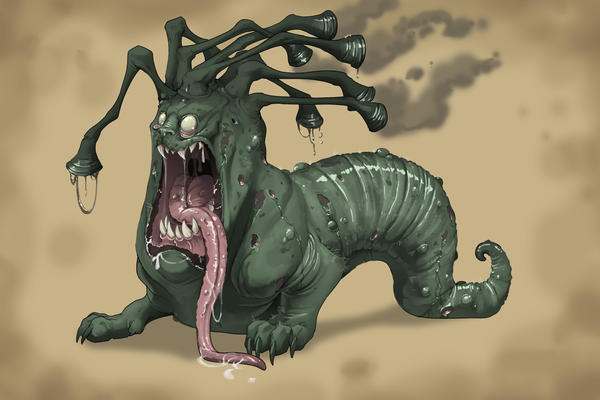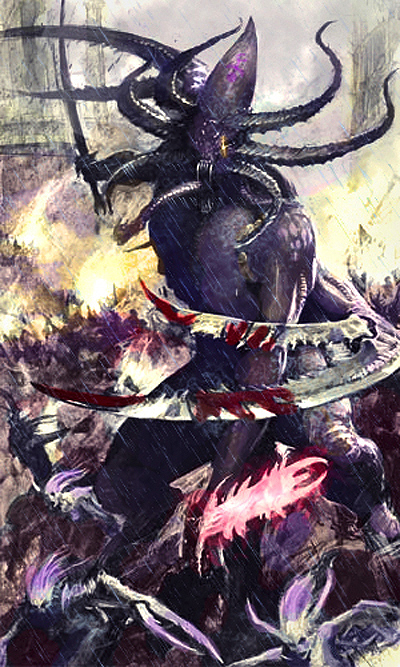 Hey all, Learn2Eel here and I want to talk about our quirky and quick Elites slot this time around. Though they are more reliant on smaller multi-wound units than large numbers, their speed and capabilities make them more useful than at first glance. I hope you like them!
Hey all, Learn2Eel here and I want to talk about our quirky and quick Elites slot this time around. Though they are more reliant on smaller multi-wound units than large numbers, their speed and capabilities make them more useful than at first glance. I hope you like them!A quick note; this Tactica was written during the release fortnight for Chaos Daemons. Thus, the Tactica does not account for the new Tau release.
Elites
Our Elites are typically designed for a specific purpose, whether it is harassment or stacking with other assault units, and they lack any real upgrades to improve their versatilty. It should be noted that each of these units is a squad comprised of multi-wound models, and each is quite susceptible to instant death from commonly found weapons such as missile launchers, battle cannons and demolisher cannons. Though their offensive capabilities tend to be quite strong, most of them work best in conjunction with others in a supporting role.
Bloodcrushers of Khorne - Fast, hard-hitting, fragile. Those four words describe Bloodcrushers in a nutshell, though I think "expensive" is also highly appropriate. As cavalry, they are highly mobile and should easily get into combat by turn two, meaning they will spend less time out in the open - terrain is a good idea, at least to block line of sight. When they do make combat, they hit harder than any unit has a right to - on the charge, each model puts out a whopping four Weapon Skill five, Strength six, Initiative four AP three attacks. It just rolls off of your tongue - ideally, they can obliterate entire squads in just two rounds, if not one, though it is preferable to win combat in the opponent's turn so as to not endure a round of shooting. Just be mindful that they lack assault grenades and thus you should be wary of charging units' sporting strength eight or higher attacks. Speaking of ranged weapons - which Bloodcrushers lack - they will ruin your day in short order; though each Bloodcrusher has three wounds, their only saving throw of note is a +5 invulnerable save which, when coupled with a Toughness of four, makes them quite vulnerable to both small arms fire and instant death. Due to the wound allocation rules in 6th Edition, you can mitigate the former kind of opposition through switching the positions of each model in a given unit as required - the real bonus to having multiple-wound models is that you can suffer unsaved wounds without actually losing models, and thus, their effectiveness. Of course, instant death makes using Bloodcrushers difficult - commonly found Strength eight ranged weapons can make for a torrid time to these Daemons, and as such, using them is not without inherent risk. Their cost is also a concern, as I am not convinced their offensive potential outweighs their fragility as much as their high cost per-model would indicate.
So, how would I recommend running Bloodcrushers? Well, it really depends on what you need them for - they will either be your hard-hitting 'monster' unit(s), or the icon-bearers to allow your other slower moving melee units to get into the fray quicker. If the former is more to your tastes, I would recommend taking five or to spread the wounds around and not make them too much of a point sink. From there, attach a Juggernaught-mounted Herald of Khorne, such as Skulltaker (or even Karanak - discussed later) and give the former a Locus as appropriate, preferably the Greater Locus of Fury so the unit dishes out a ridiculous number of powerful attacks. Add a champion with an Etherblade and they are set - the Herald and champion can deal with +2 armoured opponents, whilst the others butcher anything else. This is an expensive unit that needs to be managed carefully, particularly if your opponent does have access to Strength eight shooting at a decent range; it must be noted though that it will do very well in most combats. The latter unit need only be taken in the minimum squad size of three, with the added icon all that is necessary - run them up the field, preferably in a hidden spot, and await your reserved forces - allowing Bloodletter hordes and the like to deep-strike near enemy lines without risk is highly useful for you, and problematic for your opponent. In either role, Bloodcrushers work just fine, but I would definitely argue that Seekers of Slaanesh perform much better as a loose analogy to Bloodcrushers. Whether you agree is entirely based on preference - Bloodcrushers are fine, if uninspiring given their ease of removal. As for Karanak, adding the three headed lap-dog of Khorne to the unit of Bloodcrushers is a fantastic idea for two reasons; the first being that Bloodcrushers make a nice escort for Karanak, and the second being that it has the Scout special rule. This allows Karanak's unit to start much closer to their opponent which, if used with the appropriate amount of both precision and care, can put Bloodcrushers into a fantastic position early on. This is extremely useful regardless of how you choose to run the unit, as it gets them where they need to be much quicker - in fact, provided you go second, you can still launch a first-turn assault and have a very high chance of doing so. This is a very nasty tactic that forces your opponents hand immediately, either making them focus on the Bloodcrushers or risk losing a valuable unit.
Flamers of Tzeentch - Much like Pink Horrors of Tzeentch are the only unit that puts out firepower at range available in the Troops slot, Flamers bear the distinction of having ranged weapons whilst their peers do not. Unlike Horrors, Flamers are very much intended for harassment, where they perform this role quite well against light infantry, if a bit less impressively against medium to heavy infantry. Their use against monstrous creatures and vehicles is very limited, as they provide neither the strength nor weight of attacks to worry either from shooting or combat. Their combat abilities are better than Pink Horrors - though their Weapon Skill is lower, their stats are higher elsewhere - but it is still advisable to keep them out of it. With a Strength and Toughness of four and two wounds, they are in essence as durable as a Space Marine when one considers their +5 invulnerable save, though they are more prone to instant death from readily found Strength eight weapons such as Hades Autocannons and Battle Cannons; each of which can mean a dead squad in one round of shooting. In that sense, you need to be very careful with them - they very much emphasise the 'hit hard, die hard' aspect of Chaos Daemons, and though a decently-sized unit isn't too expensive, you still need to minimise the risks of being wiped out by weight of fire.
As to what they actually shoot, each Flamer of Tzeentch has a Strength four AP four template weapon with the Warpflame special rule - given that each model in a unit has the template, they are murder incarnate to light infantry. They can also vomit out a significant amount of wounds against medium infantry and the like with careful placement; otherwise, they won't do too well against typical enemies such as Space Marines. The Warpflame special rule is also a deterrent, as it has an even chance of giving either a light infantry squad +6 Feel No Pain or causing D3 wounds with no armour or cover saves allowed - against tougher units, it is most likely you will end up giving them +5 Feel No Pain after three rounds of shooting and killing an additional one or two, provided the Flamers survive that long. Still, Flamers are quite nasty on Overwatch as well - a welcome bonus is that their ranged attacks are not treated as psychic powers - as a cheap six-strong squad averages about twelve hits at Strength four which, against typical Space Marines, would kill two on average, and butcher other light infantry. Remember those poor Howling Banshees who seem to get worse with every passing edition, or Wyches? Those six Flamers of Tzeentch kill about eight of them from Overwatch on average, meaning you can reave entire units before they even get a chance to get close to you. What is most alluring about Flamers is that they are also Jump Infantry, meaning they can get to where you need them much quicker; they can also Deep Strike, being Chaos Daemons, and this is a risky albeit potentially highly rewarding tactic. Adding a Pyrocaster is good and cheap, just like elsewhere in the codex, and helps to minimise the effects of one particular result on the Warp Storm Table that targets your characters. It can also take gifts, though I wouldn't recommend them as you don't really want most of the benefits; rewards which are better spent on your actual commanders and the like. Overall, Flamers are a decent and cheap harassment unit that I recommend running in units of six, and though they aren't too great against Space Marines and not all that durable, their speed and devastating performance against light infantry makes them somewhat worthwhile in a balanced army - placement is key with Flamers to maximise the hits, and thus wounds, they score.
 |
| These things are all gooey and cuddly. |
As to how they actually perform in combat, against most enemies their Toughness and number of wounds alone will see them through; however, with Daemonic Instability, it is of course important that they be able to cause the wounds in return. Thankfully, they do not disappoint in this category, even if their Initiative and Weapon Skill are mediocre at best - each is only Strength four, but between Poisoned (+4) attacks where the number of attacks is the value of a D6 roll with one bonus attack (and any charge bonuses), unless you roll badly for their number of attacks they should put out a decent amount of wounds on most enemies. Though the temptation is there to use them against monstrous creatures due to their Poisoned melee attacks, I would only risk it against a low Initiative monster such as a Carnifex - the random number of attacks each turn means you are very much reliant on luck to win the day there, and unless the Carnifex has been previously wounded, it is unlikely the Beasts will be able to kill it before it strikes back and smashes (literally) through the unit.
What really makes Beasts unique is that they can 'counter-charge' in the enemy turn; if one of your opponents' units successfully charges a friendly Daemon unit, any Beasts of Nurgle unit within twelve inches must immediately declare a charge against that enemy unit, even though it is the opponents' turn. Given that they have Fleet, unless the unit is at the edge of their charge range the Beasts should pretty reliably make it into combat - this can really ruin that charging units' day, as they would have to contend not just with their initial prey but the very tough and decently hard-hitting Beasts as well. Given that Beasts also have the equivalent of defensive grenades, they are actually very good back and mid-field supporting units that work in tandem with fragile units that perform quite disastrously in combat - Pink Horrors can really benefit from the inclusion of Beasts, though they work well with nearly any unit. And, in a pinch, their speed and durability allow you to force your opponent to target them and probably waste their firepower trying to remove them, or leave them unattended and free to charge other valuable enemy units. As before, they are a headache for your enemies and their only real hindrance is an excessive cost per model; whilst I think they are worth it, they are a mighty investment, especially when I would recommend running them in at least a three-strong formation. Any more is too much of a points-sink, but you need those ablative wounds to keep the unit running tight. A good unit for a number of reasons, but as costly as they come.
Fiends of Slaanesh - If you thought Tzeentch Daemons won the prize for 'strangest appearance', you thought wrong; Fiends of Slaanesh have you covered there, and they will pretty aggressively demand your Elites slots as well. As Slaanesh Daemons, you can reasonably expect them to be fast - they are 'beasts' and thus move twelve inches each turn and are not slowed by terrain, though they do get the benefits of cover and the like. As Daemons of Slaanesh, they also add three inches to any Run moves they can make, and with the benefits of Fleet, they can get across the table in record time and roll reliably well for their random charge lengths due to the re-rolls granted by Fleet. Much like Beasts, they are a very quick harassment or flank charging unit that relies on their speed to get them to where it counts - unlike Beasts though, their greater speed comes at the cost of durability. With three wounds each at Toughness three, they are reasonably hardy when it comes to small arms fire - and even special weapons - though they run the very tangible risk of instant death from weapons such as power fists, missile launchers and battle cannons; most of which are quite common in the current edition of the game. A unit that provides a lot of attacks in combat can also worry them, such as Assault Marines, though massed bolter fire - particularly from Dark Angels wielding the Standard of Devastation - can put them down in short order. To get into combat, you are going to have to rely on their sheer speed, as well as the fact that most enemies won't perceive them as a major threat in comparison to something truly frightening like a unit of Bloodcrushers. Their combat abilities are, however, pretty decent; each Fiend strikes at Initiative six with three attacks each at Weapon Skill four that, when coupled with Rending, means they can do quite a bit of damage to several kinds of units - though Terminators and their ilk should be avoided at all costs provided they have power fists or chainfists.
Where Fiends really shine are in their two unique special rules which, combined with other units, can make for a hellish time for any opponent. The first and most controversial of which is their Disruptive Song; if a unit is charged by Fiends of Slaanesh, their Initiative is reduced by five in the first round of combat. Given that this does not have a "minimum of one" stipulation, you will be forcing most enemies in the game to give up that assault phase entirely - per the Fight sub-phase rules, there is no 'Initiative 0' step, meaning that any unit that was Initiative five or lower is reduced to 'Initiative 0' and thus cannot attack at all. Obviously, this makes up for the lack of assault grenades on Fiends, though its real uses are more pronounced when combined with other units - Bloodletters and Daemonettes afraid of striking last, or in fact, being struck at all? Pair them up with Fiends who soak up the Overwatch fire and proceed to prevent enemies from striking blows in combat at all, and watch as your assault troops wipe those forces out without suffering any casualties! Even if they don't obliterate the squad in that first round of combat, the good Initiative of most Daemon units means they will likely finish the rest of the enemy forces off either before they get to strike, or simultaneously and suffer few casualties due to the earlier butchering. Editor's Note: This tactic does not apply, per the BRB FAQ specifying that combat is resolved from the 'highest Initiative step' to the 'lowest Initiative step', meaning enemies reduced to Initiative '0' would simply strike after Initiative one. Still, not bad at all!
 |
| Age-appropriate Slaanesh art? What? |
Example Builds - Though most of our Elites don't really have varying builds outside of unit sizes, I think you can still put these examples to good use;
Bloodcrushers of Khorne (4) w/ bloodhunter, etherblade, icon of chaos, attached Karanak - 325
Bloodcrushers of Khorne (3) w/ icon of chaos - 155
Flamers of Tzeentch (6) - 138
Beasts of Nurgle (3) - 156
Fiends of Slaanesh (4) - 140
Did you find this article entertaining or insightful? Or was it not up to your standards? Please let us know in the comments below - we appreciate any and all feedback. Until next time - thanks again!
Amazing article! Ive read the whole series you've written on chaos daemons and I have to say they are the best resource for any potential daemons player. Daemons have gone through some major changes in this codex, but you help keep everything clear and show the underlying strategy behind all the units. Great job!
ReplyDelete